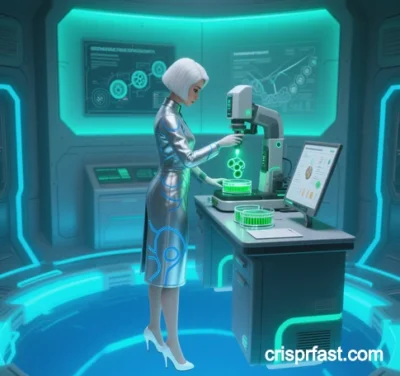 CRISPR-FAST: Ultrafast Light-Activated Gene Editing Technology and Its Core Applications
CRISPR-FAST: Ultrafast Light-Activated Gene Editing Technology and Its Core Applications
CRISPR-FAST (Far-red light-Activated Split-Cas9) is a groundbreaking gene-editing technology that uses far-red light to activate split Cas9 enzymes (N-Cas9 and C-Cas9), enabling spatiotemporal control of DNA modifications. Its advantages— deep tissue penetration (>5 mm), low phototoxicity, and programmable dynamic regulation—position it as a revolutionary tool in biomedical research, precision medicine, and synthetic biology. Below are its key applications and technological breakthroughs:
1. High-Precision Gene Editing in Deep Tissues
CRISPR-FAST overcomes the limitations of traditional CRISPR systems, enabling non-invasive editing of internal organs (e.g., liver, tumors) in mammals:
- Targeted Cancer Therapy:
In mouse xenograft models, LED-activated CRISPR-FAST edits oncogenes (e.g., PLK1), suppressing tumor growth while minimizing chemotherapy side effects. A single light pulse achieves >50% editing efficiency in tumors with no off-target effects on healthy tissues. - Organ-Specific Editing:
In tdTomato reporter mice, non-invasive far-red light activates CRISPR-FAST to edit genes in deep tissues (e.g., liver, kidney), offering potential treatments for inherited metabolic disorders like phenylketonuria.
Key Innovations:
- Light-Activation Module: Bacterial photoreceptor BphS generates c-di-GMP under far-red light (730 nm), driving BldD-p65/VP64 transcriptional activation of N-Cas9, which binds C-Cas9 via Coh2-DocS to reconstitute active Cas8.
- Nanodelivery Optimization: Minicircle DNA vectors and lipid nanoparticles (LNPs) enhance delivery efficiency and reduce immunogenicity.
2. Spatiotemporal Control and Functional Genomics
CRISPR-FAST’s subcellular resolution and millisecond activation enable real-time studies of gene dynamics:
- DNA Repair Kinetics:
Light-controlled Cas9 activation (within 30 seconds of illumination) captures the recruitment of repair proteins (e.g., BRCA1, Rad51) to DNA break sites, revealing repair initiation within 2 minutes and completion within 15 minutes. - Cell Cycle-Dependent Editing:
Synchronized cell populations allow study of gene function in specific cell cycle phases (e.g., MYC’s role in G1-phase proliferation).
Key Innovations:
- Synchronized Double-Strand Breaks: Photocaged sgRNA ensures Cas9 binds and cuts only post-illumination, minimizing off-target effects.
- Single-Allele Editing: Focused light beams edit individual alleles in diploid genomes, modeling dominant diseases like Huntington’s.
3. Synthetic Biology and Gene Circuit Design
CRISPR-FAST’s programmable logic gates drive dynamic metabolic engineering:
- Conditional Gene Circuits:
AND-gate plasmids (e.g., pAND-gate) activate Cas9 under hypoxia or high lactate levels, enabling tumor microenvironment-responsive suicide gene therapy. - Metabolic Pathway Optimization:
Intermittent light pulses regulate acs and acc genes in cyanobacteria, boosting ethylene production from 2 g/L/h to 10 g/L/h without toxic byproduct accumulation.
Key Innovations:
- Dose-Response Linearity: Editing efficiency correlates linearly with light intensity (R²>0.95).
- Multiplex Editing: CRISPR array plasmids (e.g., pCRISPR-MultiAg) enable single-light activation of 10 targets for genome-wide screens or metastatic cancer studies.
4. Clinical Translation and Precision Medicine
CRISPR-FAST’s safety and on-demand activation support clinical applications:
- Genetic Disease Therapy:
In hemophilia A mice, liver-targeted CRISPR-FAST restores Factor VIII to 70% of normal levels without hepatotoxicity. - Enhanced Immunotherapy:
Light-triggered PD-1 knockout in CAR-T cells activates tumor-specific cytotoxicity while reducing systemic immune storms.
Key Innovations:
- Dual-Factor Authentication: Blockchain tracks plasmid usage, requiring two-factor authorization for antibiotic resistance genes.
- Reversible Editing: Temperature-sensitive vectors (e.g., pX335-TS) degrade Cas9 post-editing (37°C→42°C) to prevent genomic instability.
5. Challenges and Future Directions
- Tissue Penetration Limits: Upconversion nanoparticles (UCNPs) or fiber optics may extend editing to deeper organs (e.g., brain).
- Delivery Efficiency: Organ-specific promoters (e.g., lung-targeted SFTPC) could improve non-liver targeting.
- Clinical Standardization: Global protocols for light parameters (wavelength, intensity, duration) and large-animal safety studies are needed.
Conclusion
CRISPR-FAST transforms gene editing from a static tool into a dynamically programmable system, advancing cancer therapy, genetic disease correction, and industrial biomanufacturing. With emerging technologies like quantum dot lighting and AI-driven parameter optimization, it promises single-cell precision and multi-organ coordination, heralding a new era of light-controlled life systems.
Data sources: Publicly available references. For collaborations or domain inquiries, contact: chuanchuan810@gmail.com.



